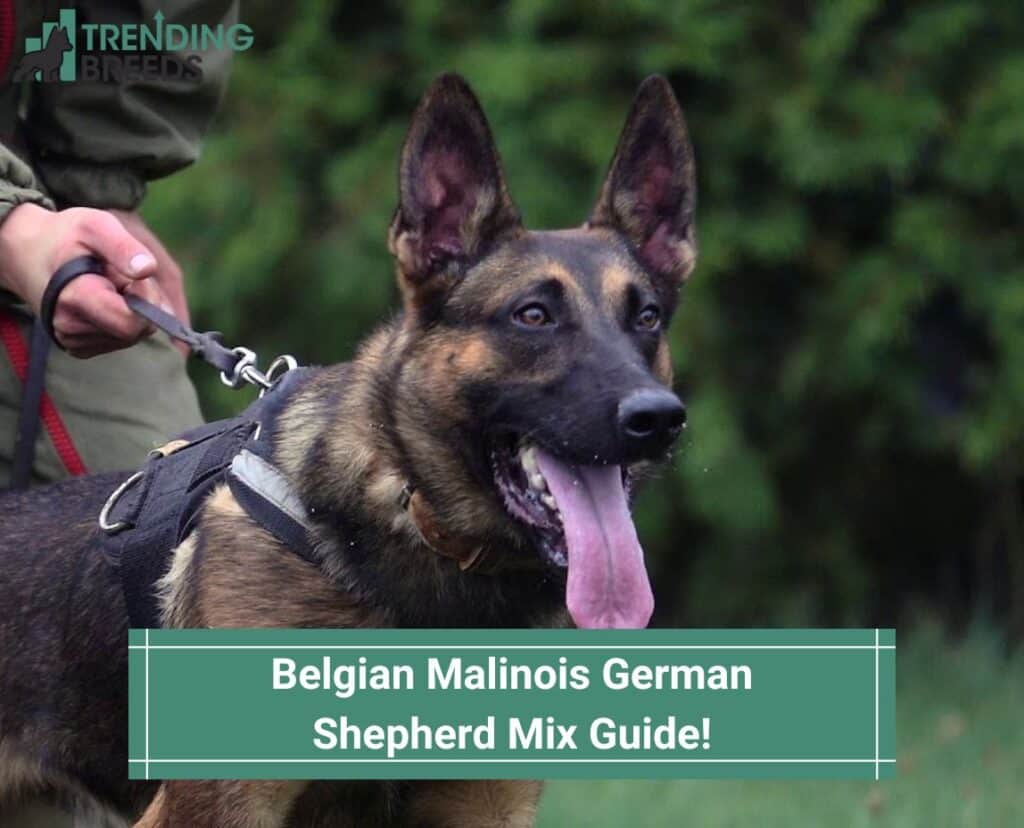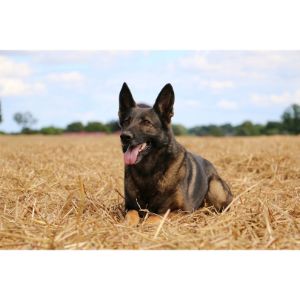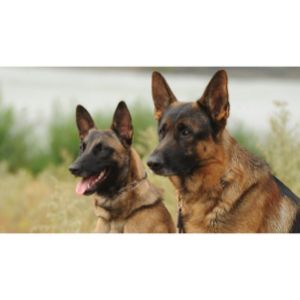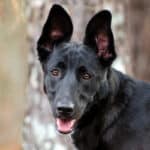
As you might suspect, the Malinois Shepherd combines Belgian Malinois and German Shepherd traits. Malinois X or Shepinois dogs are hybrid mixes of relatively new dogs. The Belgian Malinois German Shepherd mix is popular with those who love this breed.
The coat colors and general body build of German Shepherds and Belgian Malinois are relatively similar. Belgian Malinois are smaller than German Shepherds, though.
Herding was the original purpose of these breeds, so their hybrids are active, protective, and courageous. Black noses, erect ears, and a confident stature distinguish the Belgian Malinois GSD mix from other breeds.
A German Malinois mix may be difficult to distinguish from its parents. This hybrid dog combines two almost identical breeds.
There is no common breed of Malinois X. Their rarity is due to their relative newness. Designer dogs are created from purebred dogs, called hybrids or designer dogs.
Mixed-breed dogs are not recognized by the American Kennel Club (AKC). However, the German Shepherd Belgian Malinois mix can be registered with other organizations.
Other articles you would like: Basenji Border Collie Mix Guide and Basenji Jack Russell Mix Guide
Table of Contents
Belgian Malinois German Shepherd Mix

Appearance
Despite being a mix of Belgian Malinois and German Shepherd, the Belgian Malinois German Shepherd mix is an attractive dog. Between 40 and 80 pounds and 22 to 26 inches in height, they can weigh anywhere from 40 to 80 pounds.
They come in three main colors: black, tan, red and black. The Belgian Shepherd is another name for them.
Temperament
Belgian Malinois mixes possess a variety of personalities and behaviors based on various factors, such as their origin, background, and early training and socialization.
However, there are some generalizations to be made about the temperament of this crossbreed.
The Belgian Malinois mix is typically an energetic and active dog that needs to be exercised regularly. They are also relatively easy to train due to their intelligence and eagerness to please their owners.
To ensure good behavior, we must start consistently training them early. They can also be very independent and strong-willed, so we must start training them early.
They are generally friendly and affectionate towards their families. Although, in the event of a threat, they won’t hesitate to defend themselves.
When they are young, socialization is also important because they may be protective of strangers or other animals.
The Belgian Malinois Shepherd mix should be exercised daily since both breeds are energetic and highly intelligent. Keeping them entertained and physically active is also essential to keep them from boredom.
Playtimes with interactive toys, obedience training, and puzzle toys can all help to accomplish this.
Belgian Malinois Care

It’s not for everyone to own a Belgian Malinois. These dogs need space to run and play, so they don’t do well in apartments.
The dogs will benefit from having plenty of opportunities to exercise their minds and bodies with owners who lead an active lifestyle.
These dogs need to be properly trained and socialized to ensure they are well-mannered. They are also relatively easy to groom.
Exercise
An active daily exercise regimen and mental stimulation are vital for Belgian Malinois.
The animal might become anxious or develop behavioral problems if it does not receive proper care. Daily exercise is essential, including walking, running, hiking, and playing fetch.
Dog sports or any activity that uses focus and endurance to challenge this breed mentally and physically are also excellent candidates for this breed.
Due to its herding instinct, Belgian Malinois may chase moving objects such as cars, bikes, and other animals. A leash or fenced area are the only ways to keep it under control.
Training and exercise are essential for a Belgian malinois German shepherd mix to be happy and healthy. These dogs require a lot of energy and intelligence due to their high energy levels.
A structured obedience training program, daily walks, and engaging playtime are essential. Destructive or hyperactive behavior may result if they do not get enough exercise and mental stimulation.
Approximately 30 to 60 minutes of moderate exercise per day will be needed. Walks, runs, and yard games can all be part of this activity. Exercising them regularly can prevent them from becoming hyperactive or destructive.
They require work since they are energetic breeds. Competitor obedience or herding are common uses of Belgian malinois German shepherd mixes. Also, they are excellent tracking/patrol dogs, police dogs, and search and rescue dogs.
These dogs need a family that spends time at home or in the yard. While owners leave the dog alone outside, other breeds that are less energetic but still good with kids should help keep these dogs active and engaged.
If trained and exercised properly, a Belgian malinois/German shepherd mix makes a great family pet. A home that is right for these dogs can enjoy having one of these dogs as a member.
Grooming
This breed of dog has a short, straight coat in which the undercoat is dense and weather-resistant. Grooming is generally not needed beyond basic care.
Maintain a weekly brushing schedule to prevent mats and remove loose fur. Brushing more frequently in the spring and fall as the weather changes is often necessary.
It would help to trim your dog’s nails about once a month. When dogs walk on pavement, their nails naturally wear down, allowing them to go longer between nail trimmings. It should also be brushed every day.
Despite its dense double coat, the Belgian Malinois German Shepherd mix sheds relatively little for a dog with a dense double coat.
Most dogs’ coats can be kept healthy with weekly brushing. About once a month, they should be bathed, their ears cleaned, and their nails trimmed.
This Belgian Malinois X German shepherd mix has a two-layer coat that needs grooming. Keeping your dog groomed is very important.
Brush your dog at least once daily. Although more predominant during seasons of change, they shed somewhat frequently all year round.
Dogs’ teeth can be scraped or brushed daily or weekly to prevent dental disease and the pain that comes with tooth decay.
To maintain proper foot health, the dog should receive a bath every few months, and its nails should be trimmed every 2-3 weeks by a professional groomer. The ears must also be cleaned every 1-2 weeks to remain healthy.
Training
A typical characteristic of this breed is its trainability, intelligence, and eagerness to please. If reinforced positively and instructed consistently, it responds well.
Belgian Malinois puppies should be trained and socialized early in their lives. When your dog reaches the age requirement, enroll him in a puppy obedience class and expose him to different people, animals, and situations.
When exposed to other dogs early on, Belgian Malinois are likelier to get along with them. Families with children may not always be able to rely on this breed.
Kids may feel threatened by its herding instinct. Even if you don’t have children, you should train your dog to behave well around children so that you can control the situation safely.
Common Health Problems

Among the health concerns of the Belgian Malinois German Shepherd mix are dysplasia of the hips, elbows, and eyes and diseases such as corneal distichiasis and entropion.
Epilepsy and kidney stones are also common diseases among similar breeds. The dogs can, however, be easily trained and managed in daily care since they are intelligent and learn commands quickly.
In addition to being used as working dogs, Belgian Malinois German Shepherd mixes also make good pets. Because of their high energy level and frequent activity, they may develop health problems such as arthritis and hip pain.
In order to protect your puppy from getting common health problems, make sure you ask your puppy’s breeder about the parents’ possible hereditary diseases.
To keep your dog from developing any of these conditions, ensure they have regular checkups for their lives.
Living With A Belgian Malinois
It is a good-natured and obedient dog, the Belgian Malinois. The instincts he has to protect and defend his territory are strong.
It is important to socialize this breed early on and to train it firmly but not harshly. Training and socializing Belgians early on is important as they have an instinctive protective nature.
It is unnecessary to give your Belgian any training in protection unless you specifically work in a protection sport. Finding the right home for a Belgian will make a fantastic pet, as they thrive in a loving companionship environment.
As herding dogs, Malinois are instinctively keen to chase and circle, to move effortlessly for long periods of time, and to chase after people with their paws.
Toddlers who run and scream should not be given the dog if they want to work or compete in obedience. Keeping the toddler in one spot will constantly be the objective of a Belgian Malinois!
An apartment can be home to a Belgian Malinois if sufficiently exercised. Having moderate activity indoors, he will benefit from a yard at least the size of an average property.
Despite his preference for cool climates, he can adapt easily to other environments. There is a 12 to 15-year life expectancy for a Belgian Malinois.
A Belgian mixed breed is adaptable and can live in various environments. It is recommended that they go on plenty of walks and runs with moderately active families. Their needs for a large yard are not suited to apartment living.
Most of these dogs need someone to be around in their home since they are fairly active.
A large yard is necessary since they are not suitable for apartment living. They can become hyperactive or destructive if left alone for a long period.
About The Parent Breeds

Understanding the parents of the mixed breed will help you understand more about the Malinois X and allow you to decide if it’s the right dog breed for your family.
German Shepherd
The German Shepherd dog breed was created by combining different herding dogs in the late 1800s by a German captain named Max von Stephanitz.
German Shepherds became the best herding dogs Germany had ever seen as time passed, and they began demonstrating their true abilities.
German Captain Max von Stephanitz created the breed in the late 1800s by combining different herding dogs. German Shepherds became the best herding dogs Germany had ever seen as time went by, and they showed their true skills.
Even today, German Shepherds are still used to herd livestock on farms and ranches worldwide, including in the United States. It is fun for German Shepherds to learn new skills in addition to their regular duties.
You may wonder if German Shepherds are related to bears because they frequently resemble big teddy bears. German Shepherds enjoy long naps and cuddle sessions when they are not working.
Belgian Malinois
This breed of dog originates from Belgium and is very popular. Belgian herding canines are one of four breeds recognized in the country as distinct breeds. From the Malines city, it got its name in the late 1800s when it was developing.
Its abilities in herding and problem-solving make the Belgian Malinois stand out among other breeds. In addition to being an extraordinary working dog, it is also a fearless guard dog.
They have proven to be excellent tracking and search and rescue dogs because of their strong will and insistence on working. The Belgian Malinois is thus a dog that is often used as a diligent worker rather than a family pet.
Although Belgian Malinois can be stubborn, this doesn’t mean they’re not affectionate! The heart of a Mal is full of love for its owner. As a result, Malamutes are not considered aggressive dog breeds.
The problem with high energy levels is that they usually get overwhelmed! Without proper socialization, this can be easily mistaken for aggressive behavior.
There isn’t enough time for Mals to cuddle and relax. There seems to be no end to their zoomies! When it comes to Belgian Malinois dogs, you have to go fast!
Make sure you buy a German Malinois from a reputable breeder if you decide to purchase one. Buying puppies from backyard breeders and puppy mills should be avoided.
In contrast, if you adopt a Malinois X, you should know these dogs may exhibit difficulties or misbehavior. A professional trainer should be consulted if this happens to ensure your family’s safety.
You will also like:
For more information about the Belgian Malinois German Shepherd Mix, check out the video below:




